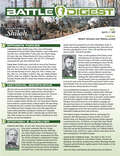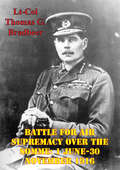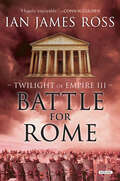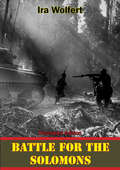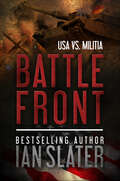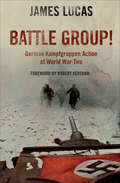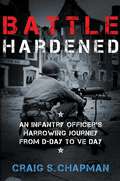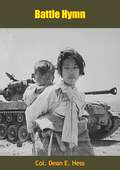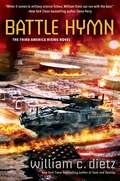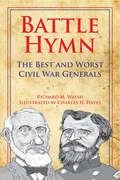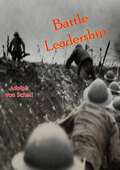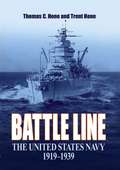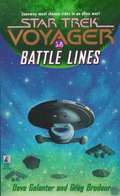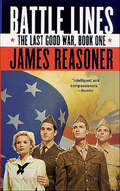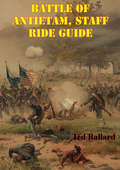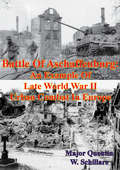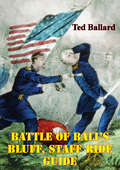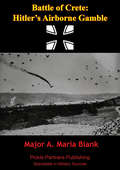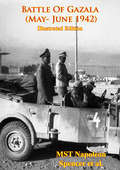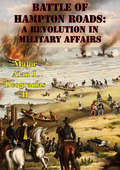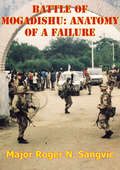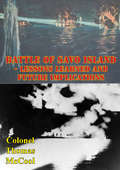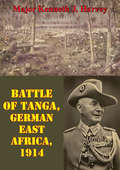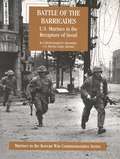- Table View
- List View
Battle Digest: Shiloh (Battle Digest Series)
by Michael E. Haskew Christopher J. PettyThe Battle Digest summary includes all the key aspects of the campaign and battle, including maps, images, and lessons learned. After his early success in the Civil War’s Western Theater, Maj. Gen. Ulysses S. Grant moved south to capture the key railroad hub at Corinth and further cut into the Confederate hold on the Tennessee and Mississippi River Valleys. But Confederate Gen. Albert S. Johnston wasn’t playing by Grant’s script. Instead of waiting for Grant to combine armies with Maj. Gen. Don Carlos Buell, Johnston moved north for a surprise attack. It almost worked. But after taking a beating the first day, a resolute Grant rallied his army and pushed the Confederates back, salvaging victory from what appeared to be certain defeat and further opening the Confederacy’s vulnerable Western flank. But Shiloh was also a sobering wake-up call for both sides. With carnage on a scale not seen before, all illusions of a short and low-cost war were shattered.
Battle For Air Supremacy Over The Somme: 1 June-30 November 1916
by Lt-Col Thomas G. BradbeerMuch has been written about the Battle of the Somme. From July through late November 1916, British, French, and German armies fought one of the costliest battles of the twentieth century. Well over a million casualties and only a few miles of ground gained by the Allies were the result when the battle ended. Little, however, has been written about the second battle which occurred simultaneously, this one in the skies above the Somme, where for the first time in the history of warfare a deliberate attempt was made to control the sky. The British Royal Flying Corps, under the resolute command of General Sir Hugh Trenchard, fought to gain air supremacy from the German Air Service. Trenchard believed that the best way to support the ground force was to dominate and control the sky above the battlefield. This air campaign was critical because of its impact on the doctrine and theory of air warfare which followed it.This study examines the efforts of the Royal Flying Corps to gain air supremacy against the German Air Service before and during the Battle of the Somme.
Battle For Rome: Twilight of Empire III (Twilight of Empire #3)
by Ian James RossIn this &“well-crafted, atmospheric&” war novel set in ancient Rome, an officer battles under Constantine while in the midst of personal turmoil.(Ben Kane, author of Fields of Blood) The Roman Empire is on the brink of civil war. Only Maxentius, tyrant of Rome, stands between the emperor Constantine and supreme power in the west. Aurelius Castus is now a tribune in Constantine's army. But great honor brings new challenges: Castus is tormented by suspicions that his young wife has been unfaithful. And as Constantine becomes increasingly devoted to Christianity, he is forced to ask himself whether he is backing the wrong man. The coming war will decide the fate of empire. But Castus's own battle will carry him much further. &“Hugely enjoyable. The author winds up tension into an explosion of fast-paced events.&” —Conn Iggulden, author of Stormbird &”A thumping good read . . . thoroughly enjoyable.&” —Ben Kane, author of Lionheart &“This is up there with Harry Sidebottom and Ben Kane.&” —M.C. Scott, author of Into the Fire
Battle For The Solomons [Illustrated Edition]
by Ira WolfertIncludes the Island War In The Pacific Illustration Pack - 152 maps, plans and photos.Pulitzer Prize winning author Ira Wolfert provides a gripping eye-witness account of one of the pivotal campaigns of the Second World War.The campaign to liberate the Solomon islands from Japanese domination, which had crept sloe to cutting off Australia and New Zealand, was hugely important in regaining the initiative for the Allies in the Pacific. The action in this account is centered around the legendary fighting on Guadalcanal, in the air, on the sea and on the land. The author toured the area recording the thoughts, feelings and anecdotes of the American Marines, Soldiers, Sailors and Airmen who fought this brutal but successful campaign. Weaving all of these parts into a narrative of vivid clarity he captured the spirit of the "Greatest Generation" as they faced their most implacable enemy, the forces of Imperial Japan.
Battle Front (USA vs. Militia)
by Ian SlaterThe final collapse of trust between the ruled and the rulers has happened in an America where civil war rages again. From bestselling author Ian Slater. "As impelling a storyteller as you're likely to encounter."—Clive Cussler The Federals drew first blood as battalions of freedom fighters went tank-to-tank with the National Guard in the Northwest. Though the President declares the area secure, top officials know the truth: The Militia movement is spreading from the fringes like wildfire, now more organized, committed, and violent than ever, and hellbent on an armed victory over the United States. No matter how desperately the government tries to regain its hold, the roads of America are shuddering under the columns of tanks, the skies throbbing with Blackhawks. Two hundred thousand trained militiamen are armed with high-tech killing tools and the courage of true believers. And after a spark ignites the Everglades, the USA takes the most explosive hit of all.
Battle Group!: German Kamfgruppen Action in World War Two
by James LucasThe author of War on the Eastern Front offers an in-depth analysis of Nazi Germany&’s shock troop tactics in every theater of WWII. The German army in the Second World War sought to fight and win swift, decisive victories in a succession of short campaigns known as blitzkrieg, or &“lightning war.&” Flexibility was as essential as the will to win. Battle groups, or shock troops, were created from miscellaneous and often disparate military units to undertake a specific local operation; it was the army's skill in combining superior numbers, aggressive tactics and the battle group commander's ability to exploit the changing situation on the ground which brought success on the battlefield. The actions described here cover all theaters of the war, and include battle groups large and small, deployed usually to smash a breach in the enemy line or seal off an enemy penetration. It covers operations in the first dynamic years when Wehrmacht forces defeated the armies of one European country after another in fast campaigns, through to the years after Stalingrad and Africa as they moved towards defeat. The battle groups&’ contribution to Wehrmacht fortunes offer powerful lessons in the tactics of battle management, and this book by James Lucas, a military historian known for his close studies of the German soldier, is considered to be one of the most detailed and authoritative accounts on the subject.
Battle Hardened: An Infantry Officer's Harrowing Journey from D-Day to V-E Day
by Craig S. ChapmanBattle-Hardened: An Infantry Officer's Harrowing Journey from D-Day to VE-Day tells the story of an American soldier's growth from a 2nd Lieutenant eager to prove his worth in battle to a skilled and resolute commander over the course of the Northern European Campaign. Craig Chapman delves deep into the personal recollections and mental state of Bill Champman as he fought against the Nazis, enduring frontline combat and witnessing horror on a massive scale. Lieutenant Chapman maintains his sanity by isolating his emotions from the chaos of the battlefield, and the young officer turns into a hard-edged warrior who dispassionately orders men to risk their lives yet still manages to hold onto his humanity.
Battle Hymn
by Col. Dean E. HessThe explosive, true story of a man of God turned fighter pilot who fought and prayed his way through 300 combat missions and two wars.Author Dean E. Hess is the subject of this inspiring autobiography, Battle Hymn, first published in 1956, which tells of his experiences as a U.S. Air Force colonel, including his involvement in the so-called “Kiddy Car Airlift” during the Korean War on December 20, 1950.With the airfield over capacity, Hess sent Korean orphans to an orphanage in Seoul. When the North Korean forces began to capture the city, Hess reportedly organized 15 C-54 Skymaster aircraft to airlift 950 orphans and 80 orphanage staff from the path of the Chinese advance to safety on Jeju Island. When Hess departed Korea in June 1951, a new orphanage on this island held over 1,000 Korean children.The book later served the basis for the 1957 film of the same name, where he was played by Rock Hudson.“Stirring”—San Francisco Chronicle“In his career as a war correspondent Quentin Reynolds has met his share of heroes, but few of them, he says have impressed him as deeply as Col. Dean E. Hess.”—Readers Digest“Twentieth century American soldiers, sailors, airmen and Marines have enjoyed a warm reputation for caring about the children of the lands they have fought in. Col. Dean E. Hess—Air Force humanitarians—well represents this tradition.”—The Times Magazine
Battle Hymn
by William C. DietzFrom the New York Times bestselling author of the Legion of the Damned® novels comes the final volume in the postapocalyptic military science fiction trilogy about America warring with itself and the people trying to keep it together...The Second Civil War continues to rage as Union president Samuel T. Sloan battles to keep America whole and, more than that, to restore the country to its former greatness."Wanted Dead or Alive." Following a fateful battle between Union Army major Robin "Mac" Macintyre and her sister, the New Confederacy places a price on Mac's head, and bounty hunters are on her trail.But there's work to be done, and Mac is determined to help Sloan reunify the country by freeing hundreds of Union POWs from appalling conditions in Mexico and capturing a strategic oil reserve that lies deep inside Confederate territory.However, to truly have peace it will be necessary to capture or kill the New Confederacy's leadership, and that includes Mac's father, General Bo Macintyre.
Battle Hymn: The Best and Worst Civil War Generals
by Richard M. WalshAn entertaining, informative, and unbiased look at the American Civil War&’s best and worst military leaders. Want to know which general was the most respected by soldiers on both sides? Or why George Thomas is considered the best combat general of the war? Read history professor Richard M. Walsh&’s entertaining book! In it, he reveals the strengths and weaknesses of the Civil War&’s top generals. Find out why Nathan Bedford Forrest and William T. Sherman are both hated and respected. Discover why Stonewall Jackson was considered the best combat leader in the Confederacy and why George McClellan was called &“Little Napoleon.&” Walsh even includes citizen soldiers Patrick Cleburne and Joshua Lawrence Chamberlain in his chronicle. Satirical portraits scattered throughout add to the fun of this educational read.
Battle Leadership
by Adolph Von SchellBattle Leadership by Adolph von Schell is a timeless and insightful examination of the psychological and practical aspects of leadership in combat. Von Schell offers a profound exploration of the challenges faced by leaders on the battlefield and the strategies necessary to inspire and maintain the morale of troops under the most extreme conditions.In this concise yet impactful work, von Schell emphasizes the importance of understanding the human element in warfare. He argues that beyond tactics and strategy, effective leadership in battle requires a deep awareness of the psychological pressures faced by soldiers, including fear, stress, and the uncertainty of combat. Von Schell shares practical advice on how leaders can build trust, communicate effectively, and make quick decisions that instill confidence in their men, even in the chaos of battle.Battle Leadership is rich with anecdotes and lessons learned from the front lines, offering readers a rare glimpse into the mindset of a combat leader. Von Schell’s reflections are grounded in real-world experience, making his insights both credible and relatable for military professionals and anyone interested in leadership under pressure.The book also delves into the dynamics of small unit leadership, highlighting the critical role of junior officers and non-commissioned officers in maintaining the cohesion and effectiveness of their units. Von Schell’s observations on the importance of adaptability, initiative, and the moral responsibilities of leadership remain highly relevant to military leaders today.Battle Leadership is essential reading for military officers, historians, and students of leadership. Adolph von Schell’s wisdom transcends time and context, offering valuable guidance for anyone tasked with leading others in difficult and demanding situations. This classic work continues to inspire and educate new generations of leaders, reinforcing the enduring principles of courage, decisiveness, and empathy in the art of command.
Battle Leadership: Some Personal Experiences of a Junior Officer of the German Army with Observations on Battle Tactics and the Psychological Reactions of Troops in Campaign
by Adolf Von SchellA collection of lessons learned by Adolf von Schell, a small unit infantry commander during World War I.
Battle Line
by Thomas C. Hone Trent HoneA portrait in words and photographs of the interwar Navy, this book examines the twenty-year period that saw the U.S. fleet shrink under the pressure of arms limitation treaties and government economy and then grow again to a world-class force. The authors trace the Navy's evolution from a fleet centered around slow battleships to one that deployed most of the warship types that proved so essential in World War II, including fast aircraft carriers, heavy and light cruisers, sleek destroyers, powerful battleships, and deadly submarines. Both the older battleships and these newer ships are captured in stunning period photographs that have never before been published. An authoritative yet lively text explains how and why the newer ships and aircraft came to be. Thomas Hone and Trent Hone describe how a Navy desperately short funds and men nevertheless pioneered carrier aviation, shipboard electronics, code-breaking, and (with the Marines) amphibious warfare - elements that made America's later victory in the Pacific possible. Based on years of study of official Navy department records, their book presents a comprehensive view of the foundations of a navy that would become the world's largest and most formidable. At the same time, the heart of the book draws on memoirs, novels, and oral histories to reveal the work and the skills of sailors and officers that contributed to successes in World War II. From their service on such battleships as West Virginia to their efforts ashore to develop and procure the most effective aircraft, electronics, and ships, from their adventures on Yangtze River gunboats to carrier landings on the converted battle cruisers Saratoga and Lexington, the men are profiled along with their ships. This combination of popular history with archival history will appeal to a general audience of naval enthusiasts.
Battle Lines: Star Trek Voyager (Star Trek: Voyager #18)
by Dave Galanter Greg BrodeurWhile exploring a sector of uncharted space, the U.S.S. Voyager is ambushed -- and forcibly pressed into service as part of the Edesian Fleet in their war against the enemy Gimlon. The Edesian commander claims that the Fleet is fighting only to defend his people against a merciless invader, but Captain Janeway is suspicious. War, she has learned, is seldom so simple or black and white. With Chakotay and several other crew members held hostage, and the Starship Voyager under the control of the Edesians, Janeway has no choice but to join the campaign against the Gimlon, only to discover that the enemy has developed a new super-weapon capable of destroying entire worlds. Soon the Captain and her crew find themselves fighting a losing battle in a war they never wanted!
Battle Lines: The Last Good War, Book One (The Last Good War #1)
by James ReasonerIt is 1941, and friends Adam, Joe, Dale, and Catherine are similar to most young adults. College, dating, and fast cars are what they know and live for. And in Chicago, Illinois, the near center of America, world conflict seems merely a distant rumor.But as turmoil in Europe develops into full-scale war, Chicago suddenly abounds with talk of America's entering the fight. Drawn by the promise of freedom and the allure of battle, Joe and Dale join the Army, Adam the Marines, and Catherine the Naval Nurse Service. Far away from home and facing the reality of war in all its horror, they find the world a frighteningly big and unforgiving place, and what began as a quest for freedom becomes a battle to stay alive in one of the bloodiest wars of the twentieth century.At the Publisher's request, this title is being sold without Digital Rights Management Software (DRM) applied.
Battle Of Antietam, Staff Ride Guide [Illustrated Edition]
by Ted BallardContains more than 20 maps, diagrams and illustrationsThe Battle of Antietam has been called the bloodiest single day in American History. By the end of the evening, 17 September 1862, an estimated 4,000 American soldiers had been killed and over 18,000 wounded in and around the small farming community of Sharpsburg, Maryland. Emory Upton, then a captain with the Union artillery battery, later wrote, "I have heard of 'the dead lying in heaps,' but never saw it till this battle. Whole ranks fell together." The battle had been a day of confusion, tactical blunders, individual heroics, and the effects of just plain luck. It brought to an end a Confederate campaign to "liberate" the border state of Maryland and possibly take the war into Pennsylvania. A little more than one hundred and forty years later, the Antietam battlefield is one of the best-preserved Civil War battlefields in the National Park System.Antietam is ideal for a staff ride, since a continuing goal of the National Park Service is to maintain the site in the condition in which it was on the day of the battle. The purpose of any staff ride is to learn from the past by analyzing the battle through the eyes of the men who were there, both leaders and rank-and-file soldiers. Antietam offers many lessons in command and control, communications, intelligence, weapons technology versus tactics, and the ever-present confusion, or "fog" of battle. We hope that these lessons will allow us to gain insights into decision-making and the human condition during combat.
Battle Of Aschaffenburg: An Example Of Late World War II Urban Combat In Europe
by Major Quentin W. SchillareThe Battle of Aschaffenburg examines the fight for the Main River city of Aschaffenburg in the closing weeks of World War II in Europe. It investigates the reasons why it took mobile and well supported elements of the U.S. Army ten days to subdue a defending German military force that was very much militia in character. After setting the battle in the context of Nazi Germany and the Aschaffenburg region just prior to the fight, the study takes the reader through the battle day-by-day describing the struggle and establishing the reasons why it was so prolonged.The study groups the reasons for the successful German defense into three categories: terrain, operational factors and behavioral determinants. It establishes that the terrain favored the defenders with the town located across the Main River from the attackers so that they were forced into frontal assaults. Granting favorable defensive terrain, it was not until a numerically superior attacking force enveloped the urban defenses, under the cover of massive fire support, that the Americans gained the upper hand. The study further demonstrates the Impact of the concept of the will to win on military operations, even in a hopeless cause.The Battle of Aschaffenburg addresses Europe an urban combat in the context of World War II and concludes that the factors relevant to success then are still applicable. An attacker must carefully plan operations in urbanized terrain, follow doctrine and be physically and mentally prepared for a difficult fight.
Battle Of Ball’s Bluff, Staff Ride Guide [Illustrated Edition]
by Ted BallardContains more than 20 maps, diagrams and illustrationsOn the night of 20 October 1861, Union Brig. Gen. Charles P. Stone put into action a plan to attack what had been reported as a small, unguarded Confederate camp between the Potomac River at Ball's Bluff and Leesburg, Virginia. Later, after Stone learned there was no camp, he allowed the operation to continue, now modified to capture Leesburg itself. But a lack of adequate communication between commanders, problems with logistics, and violations of the principles of war hampered the operation. What originally was to be a small raid instead turned into a military disaster. The action resulted in the death of a popular U.S. senator and long-time friend of President Abraham Lincoln, the arrest and imprisonment of General Stone, and the creation of a congressional oversight committee that would keep senior Union commanders looking over their shoulders for the remainder of the war. For such a small and relatively insignificant military action, Ball's Bluff would cast a long shadow. The purpose of a Ball's Bluff staff ride is to learn from the past by analyzing the battle through the eyes of the men who were there, both leaders and rank-and-file soldiers. The battle contains many lessons in command and control, communications, intelligence, weapons technology versus tactics, and the ever-present confusion, or "fog," of battle. Hopefully, these lessons will allow us to gain insights into decision making and the human condition during combat. Today, the battlefield is enclosed in the 225-acre Ball's Bluff Regional Park, managed by the Northern Virginia Regional Park Authority. A short trail includes interpretive markers and a small national cemetery containing the remains of fifty-four soldiers.
Battle Of Crete: Hitler’s Airborne Gamble
by Major Maria A. BiankAs Adolf Hitler conquered most of the European continent in 1939-1941, the small island of Crete in the Mediterranean Sea became vital to future operations in the Mediterranean region for both the Axis and Allied powers. If the Allies controlled Crete, their air and sea superiority would not allow the Germans a strategic military foothold in the region. For the Germans, Crete would secure the Aegean Sea for Axis shipping, loosen Great Britain's grasp in the eastern Mediterranean Sea and provide air bases to launch offensives against British forces in Egypt. Therefore, the central research question is: Did the results of the German campaign in Crete justify its execution? The operational results of the German campaign in Crete and the strategic advantages gained from its success did not justify the execution of the battle. Although Germany's conquest of Crete achieved all of the strategic advantages, Hitler did not accomplish the strategic objectives set forth at the beginning of the campaign. Crete was not used as a staging base from which to engage the British in offensive operations against the Suez Canal or North Africa. German losses to the highly trained air corps were staggering and Hitler never again employed parachutists on a large-scale airborne operation. Future war efforts were deprived of this elite, highly mobile striking force. Hitler did not capitalize on the hard fought victory in Crete by using the island as a stepping-stone, ultimately controlling the eastern Mediterranean region because he was hypnotized by the invasion of Russia.
Battle Of Gazala (May- June 1942) [Illustrated Edition]
by Msg Napoleon SpencerIncludes the War in North Africa Illustration Pack - 112 photos/illustrations and 21 maps.The Battle of Gazala, fought from 26 May-20 June 1942, was Rommel's greatest triumph in battle. It is also considered the most convincing defeat of British forces during all the desert campaigns of World War II. Rommel's success was a demanding effort and rested on the exploitation of British weaknesses. It required an understanding of the environment, a commitment to the essential principles of war, and the ability and willingness to maintain initiative. The Battle of Gazala was not just a mastery of warfare by Rommel; it also illustrated (for both sides) the importance of logistics, maneuver, mass, and surprise (FM 3-0, 4-13).When analyzed individually, one, if not all the factors discussed possesses the potential to be the most significant factor(s) in the British defeat at Gazala. The Germans, specifically Rommel, understood how to combine leadership, logistics, mass, and maneuver to impose their will on the British. The British failed to incorporate lessons learned into their plans rendering them incapable of dealing with a mobile war in the Northern Desert. The Battle of Gazala in itself may not profess to be Rommel's great triumph in battle. However, Rommel's ability to apply the principles of war while outnumbered and trapped, and turning defeat into victory could very well define the Battle of Gazala as his finest moment in battle.Analysis of the Battle of Gazala provides several lessons concerning the outcome and whether or not it could be considered Rommel's greatest triumph in battle. Examining the factors presented thus far it could be concluded that British should have had the upper hand.
Battle Of Hampton Roads: A Revolution In Military Affairs
by Major Alan J. Deogracias IIThis thesis examines the Battle of Hampton Roads, 8 and 9 March 1862, the first battle of ironclads, to determine if it was a Revolution in Military Affairs. This study is an analysis of naval developments prior to March 1862, the battle, and the impact the battle had on the U.S. Navy and the Royal Navy from 1862 to 1871. The battle signaled the end of the wooden warship era when the CSS Virginia destroyed two wooden warships on 8 March 1862. The USS Monitor influenced a change in naval design, which led the U.S. Navy and the Royal Navy to build turreted warships, which culminated in the launching of the first modern battleship in 1871. The transformation from sailing and steam ships with broadside armament to steam-powered turret ships led to a reduction in the size of the crews and the acceptance of engineers into the naval community. The battle led both navies to assign ironclads to their squadrons to counter ironclads of hostile nations. The battle influenced the development of tactics for fighting ironclads including ramming and coastal warfare. The Battle of Hampton Roads was a Revolution in Military Affairs and the onset of modern naval warfare.
Battle Of Mogadishu: Anatomy Of A Failure
by Major Roger N. SangvicBy applying Cohen and Gooch's model to the Battle of Mogadishu, this paper shows that the failure of the TFR mission on 3-4 October 1993 was the result of a system failure. Secretary Aspin received far more blame than he deserved for making the decision. Misperception of the real impact tanks and APCs could have had on the overall mission is the real cause of this disproportionate blame. GEN Hoar and GEN Powell, in addition, bear as much responsibility as Secretary Aspin for the decision. Neither of these generals strongly advocated the deployment to Aspin even though the worsening situation on the ground merited their strong support. Both Hoar and Powell's approval recommendations can be characterized as lukewarm. Aspin's real failure was of not being more critical of the conduct of the TFR operations. In light of Secretary Aspin's acknowledged concern over the number of similar operations conducted by TFR and his knowledge that the Administration was seeking a political solution, he should have notified MG Garrison of the policy shift though the JCS and CINCCENT and provided additional guidance on risk. Had Aspin either reassessed the risk of each TFR operation more thoroughly or done a better job coordinating the policy shift in light of the increased risks, it is likely that the three October raid would not have occurred.
Battle Of Savo Island - Lessons Learned And Future Implications
by Colonel Thomas MccoolAs the United States enters into the 21st century, it will face new and different challenges that will be more complex than those encountered in the past. Evolutions in doctrine, training, and equipment modernization, influenced by informational and technological advances, will enhance U.S. ability to accomplish national objectives. Valuable lessons learned can be realized by studying past operations that failed to understand the threat and capitalize on friendly capabilities. The Battle of Savo Island in August 1942 is one such event. This short but violent naval engagement, a daring Japanese night surface attack conducted at the beginning of the Guadalcanal campaign on 9 August 1942, was a significant tactical victory for the Imperial Japanese Fleet and has been called the worst blue water defeat in the U.S. Navy's history. This paper will address the shortcomings at Savo Island, particularly in terms of intelligence, command and control, training, force protection, and leadership and discuss these concepts as they apply to current and future operations in the 21st century.
Battle Of Tanga, German East Africa, 1914
by Major Kenneth J. HarveyIn November 1914, British Indian Expeditionary Force "B" conducted an amphibious assault on the Port of Tanga in German East Africa. The British possessed all the tools required for success; they outnumbered the defenders almost eight to one, they possessed the only artillery and naval guns available for the battle, and they landed where the Germans were weak. Despite these factors, a hastily organized German defense force of 1,100 soldiers not only defeated the 8,000 British soldiers, but also compelled Indian Expeditionary Force "B" to retreat to Mombasa.This thesis examines the manner in which German and British forces were organized, trained, equipped, and led. Additionally, it identifies the critical factors that together led to British defeat at Tanga.
Battle Of The Barricades: U.S. Marines In The Recapture Of Seoul [Illustrated Edition] (Marines In The Korean War Commemorative Series #2)
by Colonel Joseph H. Alexander USMCIncludes over 30 maps, photos and illustrationsThe Second Battle of Seoul was the battle to recapture Seoul from the North Koreans in late September 1950.The advance on Seoul was slow and bloody, after the landings at Inchon. The reason was the appearance in the Seoul area of two first-class fighting units of the North Korean People's Army, the 78th Independent Infantry Regiment and 25th Infantry Brigade, about 7,000 troops in all.The NKPA launched a T-34 attack, which was trapped and destroyed, and a Yak bombing run in Incheon harbor, which did little damage. The NKPA attempted to stall the UN offensive to allow time to reinforce Seoul and withdraw troops from the south. Though warned that the process of taking Seoul would allow remaining NKPA forces in the south to escape, MacArthur felt that he was bound to honor promises given to the South Korean government to retake the capital as soon as possible.On September 22, the Marines entered Seoul to find it heavily fortified. Casualties mounted as the forces engaged in desperate house-to-house fighting. Anxious to pronounce the conquest of Seoul, Almond declared the city liberated on September 25 despite the fact that Marines were still engaged in house-to-house combat. Despite furious resistance by the North Korean forces, the Marines triumphed; pushing the communists soldiers out of Seoul. This U.S. Marine Corps history provides unique information about this important battle of the Korean War.
